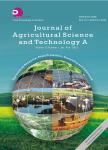Components of Liquid Media on the Production of High Spore Concentrations of Lecanicillium lecanii (Zimm.) Gams and Zare
Components of Liquid Media on the Production of High Spore Concentrations of Lecanicillium lecanii (Zimm.) Gams and Zare作者机构:Departamento de Producci6n Agricola Universidad de Guadalajara CUCBA Zapopan Jalisco 45110 Mexico Colegio de Postgraduados Texcoco Edo. de Mexico 56230 Mexico Unidad lztapalapa Universidad A utonoma Metropolitana Iztapalapa 09340 Mexico
出 版 物:《Journal of Agricultural Science and Technology(A)》 (农业科学与技术(A))
年 卷 期:2014年第4卷第9期
页 面:767-779页
学科分类:081702[工学-化学工艺] 08[工学] 0817[工学-化学工程与技术] 09[农学] 0904[农学-植物保护]
主 题:分生孢子 生产过程 液体介质 Richards模型 浓度 组件 菌株生长 摇瓶培养
摘 要:Two Lecanicillium lecanii isolates, ATCC26854 and V3, were evaluated for spore production in liquid media. Both isolates have interesting known properties for the production of high concentrations of chitinases (ATCC26854), and an outstanding pathogenic activity against the green cabbage aphid, Brevicorine brassiacae (L.). The isolates were grown on thirteen different liquid media, which had been used to produce other entomopathogenic Hyphomycetes. Experiments were carried out at 27 ± 1 °C with a 12:12 photoperiod using shake flasks. The production of spores was quantified during a seven days period, and the effects of the media were evaluated by determining spore concentration and morphology. Submerged conidia yields were higher with ATCC26854 than with V3 in all thirteen media, while higher concentrations (5.3 × 109, 4.6 × 109 and 3.4 × 109 conidia/mL) were found with ATCC26854 isolate in the Camaron, Minerales and Jenkins-Prior medium, respectively; lower yields (2.3 × 108, 2.2 × 108 and 2.3 × 108 conidia/mL) were found with the V3 isolate in Catroux, TKI and Camaron media, respectively. Spore production curves were adjusted to different sigmoid models. The process was better explained by the Richards model (r2 = 0.99). Concerning conidia morphology, submerged conidia seemed to look like aerial conidia, but they were different in size (ATCC26854 2.73-6.99 μm and V3 5.28-14.29 μm); however, the dimensions fall within the ranges reported for L. lecanii. The analysis of shake flask cultures with the Richards model allowed selecting two low-cost liquid medium, Camarón and Jenkins-Prior, for scaling up conidia production for use in aphid biological control programs.



